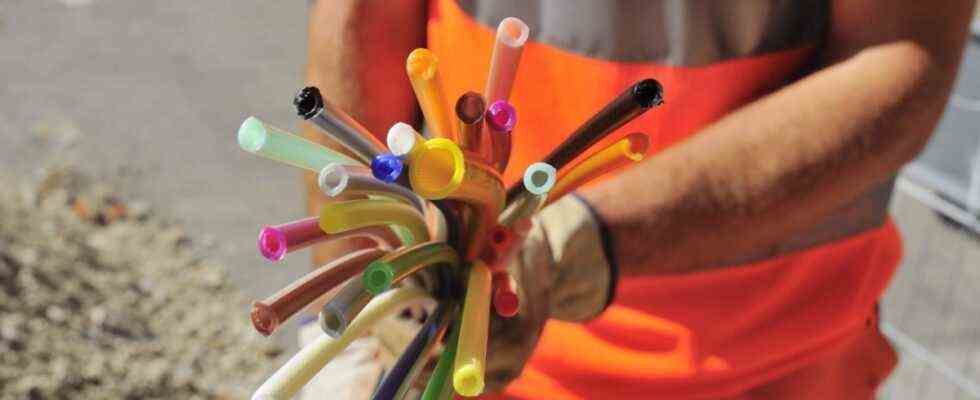If you navigate to Munich in the broadband atlas of the Federal Ministry for Digital and Transport (BMDV), you will come across a surprising number of light gray spots. Light gray is bad. It means that there are particularly few fiber optic cables in an area, so only slow internet is available.
The outskirts of Munich in particular are gray; on the city limits, the patches become contiguous fields. Now these could soon dissolve in the east as well. Surprisingly, parts of Berg am Laim and Trudering are to be connected to the fiber optic network as early as 2023, with further quarters to follow by 2025.
The picture is a bit pixelated. Alexander Friedrich (SPD), chairman of the district committee (BA) Berg am Laim, is easy to spot when he calls someone up and gives the floor. Sometimes he half disappears from the picture because he is discussing a voting result with an administrative employee. His table on the stage in the Trudering cultural center has been in focus for some time when the monthly meeting of the committee is broadcast as a live stream on the Internet.
The committee in Berg am Laim is one of the few district committees in the city that has decided to stream its meetings. In many places it failed because of the knowledge or the technical equipment of the meeting places. The cultural center on Wasserburger Landstrasse, which opened in 2005, also has such a weak point: the Internet is not strong enough to broadcast events in real time. The BA has found its own solution; the committee uses the cellular network with a mobile router. Like 83 percent of the households in Trudering and Riem, the cultural center is not connected to the fiber optic network.
Telekom is taking over the expansion on the outskirts
This could change soon. At a Deutsche Telekom summit with representatives from the Bogenhausen, Berg am Laim, Trudering-Riem and Ramersdorf-Perlach district committees, it was announced in mid-December that parts of the city districts would be connected to the fiber-optic network. In the coming years, Telekom plans to invest 500 million euros in the digital infrastructure of the Bavarian capital, bringing 300,000 more Munich households online.
In October, the company started its fiber optic expansion in the south-west of Munich. In Hadern, therefore, 15,000 households have the option of being connected to the Telekom network. In the future, you will be able to access the Internet at speeds of up to one gigabit per second (GBit / s). The cable does not end at the distribution box, but is laid directly in the house or apartment (FTTH, fiber to the home). Fürstenried has been on it since November. In 2022, Aubing, Forstenried, Sendling-Westpark and Thalkirchen are on the agenda.
The fact that Telekom is involved in Munich also has to do with the fact that M-net, which is backed by Stadtwerke München, among others, no longer wants to promote the business of fiber optics and the G 5 mobile communications standard across the board. The history of the broadband network and the city of Munich is a good decade old – and associated with ups and downs. While Munich was one of the first major German cities to operate its own operations in around 20,000 inner-city buildings with fiber optic cables, the expansion steps outside of the Middle Ring were long slow.
Today around 630,000 Munich households and commercial units in the city area have a fiber optic connection from M-net. According to the Stadtwerke, 70 percent of Munich residents would have access to high-performance internet.
And the remaining third? In March, the municipal utilities responded to a city council request from the Free Voters / ÖDP parliamentary group that a procedure as before was “economically unacceptable”. In other words: M-net only wants to lay cables in new building areas where digging is going on anyway, and where enough people live or work.
“The current supply through vectoring and coaxial cable Internet is too good for the fiber optic expansion to be supported by federal funding,” explains Stefan Hofmeir, who runs a streaming and webhosting service in what was previously a “gray” residential area in Berg am Laimer the ÖDP sits in the district committee and also organizes the live stream from the cultural center there.
Fiber optic line towards the hair
He has been dealing with the topic for eight years, applying for a better internet connection – initially as a citizen, now as a local politician. “After there was still no connection in sight at the beginning of the year and we seriously looked at offices in better-supplied streets, I ordered an individual fiber optic connection at the end of March,” he says. So the entrepreneur had the cables laid in his house at his own expense. “We now have one Gbit / s in both directions for the proud price of a little over 1000 euros a month,” says Hofmeir. That is very expensive, “but it was definitely cheaper than moving,” he says.
Hofmeir is pleased that there is progress in matters of the Internet. Exact expansion maps are not given by Telekom, but representatives of the company have signaled that from 2023 on, “construction will start from St.-Veit-Straße in the direction of Haar”. According to this, fast internet could probably be available in Waldtrudering in 2025. Owners who opt for a connection during the construction phase will receive it free of charge. Anyone who decides to do this later has to pay for the civil engineering themselves.

